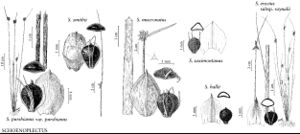Schoenoplectus hallii
Novon 5: 101. 1995.
Plants annual; rhizomes 1 mm diam. Culms often arching to decumbent, cylindric, ridged when dry, 0.05–0.8 m × 0.5–1 mm. Leaves 3–4, 1 cauline; sheaths straw-colored to brown and disintegrating to fibers, front translucent and splitting; blades 1–2, proximally thickly C-shaped in cross section, distally flat, from much shorter to longer than sheath, 1–200+ × 0.2–1 mm, smooth or margins distally spinulose. Inflorescences capitate or 1 spikelet or rarely with 1 or 2 branches to 12 mm; proximal bract erect, resembling leaf blades, 5–150 mm. Spikelets 1–5, 5–20 × 2–3 mm; scales straw-colored to pale orange-brown to nearly colorless, midrib region usually greenish or pale, ovate, 2.5–3(–5) × 1.5 mm, smooth or awn sparsely spinulose, margins ciliolate, midrib keeled distally, apex entire, rounded, awn 0.2–0.3 mm or to 3 mm on proximal scale. Flowers: perianth absent; anthers 0.4 mm; styles 2-fid. Spikelet achenes blackish brown, plano-convex or usually the adaxial surface longitudinally concave, ovoid to obovoid, 1.3–1.7 × 1.2–1.3 mm, with 15–18 mostly sharp ridges; beak 0.1 mm. Amphicarpic achenes thickly trigonous with convex abaxial face, 1.7–2.5 × 1.1–1.6 mm, rugose with rounded ridges; beak 0.3 mm. 2n = 22.
Phenology: Fruiting summer–fall.
Habitat: Terrestrial to emergent, freshwater shores, temporary ponds, wet places in cultivated fields, pastures, ditches, sinkholes, prairie
Elevation: 70–700 m
Distribution

Ga., Ill., Ind., Kans., Ky., Mass., Mich., Mo., Nebr., Okla., Wis.
Discussion
Many reports of Schoenoplectus hallii are based on misidentified specimens of S. saximontanus or S. erectus. The Iowa specimen was probably collected in 1890. The species is probably extirpated from Massachusetts. I have identified a specimen from the Georgia coastal plain, where S. hallii and S. erectus are sympatric, as intermediate between the two.
Selected References
None.
